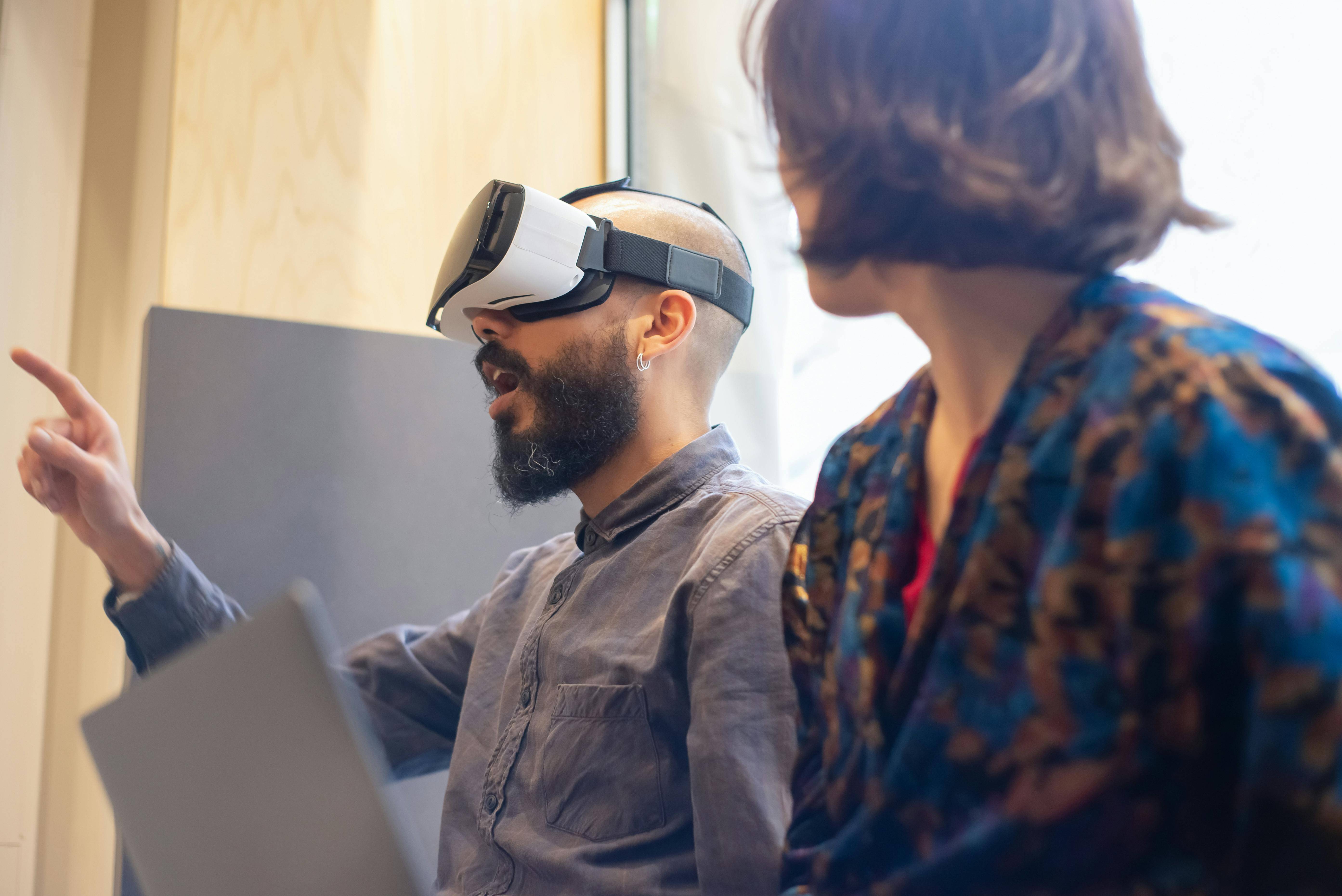While it is often associated with the entertainment or video game sector, its applications in the corporate world are many and varied. Two of the areas most impacted are employee training and the recruitment of new talent. By offering immersive, interactive solutions, VR is revolutionizing the way companies train their teams and evaluate candidates.
VR for corporate training
1. Total immersion for effective learning
Virtual reality (VR) provides employees with highly immersive and interactive learning experiences. Instead of conventional theoretical training, VR immerses learners in realistic situations where they can not only acquire technical skills, but also develop soft skills such as stress management or communication in complex situations. This enables them to be better prepared for the challenges of the field.

In the industrial sector, for example, VR simulations enable employees to practice handling dangerous equipment or carrying out technical repairs without risk. These simulations offer maximum safety, while at the same time enabling complex movements to be learned. This type of training is particularly useful in sectors such as aeronautics, where complex procedures and equipment require extreme precision.
In the medical sector, VR is opening up revolutionary prospects. Surgeons can practice on 3D anatomical models before operating on real patients, reducing the risk of error and perfecting their gestures. Procedures such as precision surgery or emergency management can be endlessly simulated.
VR environments are also particularly effective for crisis training. Employees can be confronted with unforeseen scenarios (such as a fire, a technical breakdown or a violent situation in the workplace) and learn how to react to them without suffering the consequences of real-world errors. This ensures optimum preparation for extreme situations.
This type of training provides a more interactive experience, in which learners can test their skills, make mistakes and correct them in real time, which is impossible in a traditional setting. This makes training not only more engaging, but also more effective.
2. Cost reduction and risk management
VR offers considerable cost and safety advantages, particularly in the field of training. By recreating immersive work environments, it eliminates the need to invest in physical equipment or organize face-to-face training courses. As a result, companies can reduce expenses such as space or machine rental, while avoiding the additional costs of accommodation or transportation for participants - a particularly advantageous solution for geographically dispersed teams.

Another major advantage is risk reduction. Training employees on complex equipment or in high-risk environments via VR helps prevent accidents due to mishandling. For example, in heavy industry, where human error can have serious consequences, VR offers the possibility of safely rehearsing technical gestures until they are perfectly mastered.
VR also simplifies ongoing training in demanding sectors such as healthcare and aeronautics. Thanks to this technology, companies can keep their teams up to date with new techniques and innovations at lower cost, without having to renew equipment or multiply training sessions. This flexibility guarantees efficient, cost-effective learning, while meeting the demands of constant evolution in highly technical fields.
3. Personalized skills monitoring
Virtual reality enables detailed monitoring of employee progress. Thanks to the analysis tools built into VR platforms, learners' every movement, decision and interaction can be recorded and analyzed. This provides invaluable data on their performance, enabling them to personalize their training path. Trainers can quickly identify areas for improvement, adjust session content and offer personalized feedback in real time. The ability to analyze this data enables customized training paths to be built, based on individual needs.

The use of VR also offers immediate feedback, enabling employees to correct their mistakes before applying them in a real-life context. This offers more accurate and optimized learning, while boosting employee confidence and commitment. According to a study1 by PwC (2019), users trained with VR develop greater confidence in their skills, which translates into better performance in real-life situations.
4. Distance learning and universal access
Another advantage of VR is its ability to transcend geographical constraints. In sectors such as the oil industry, where some platforms are located in hard-to-reach places, VR makes it possible to train teams without requiring their physical presence. This is particularly useful in hazardous environments, such as nuclear power plants or war zones, where the absence of risk is crucial to safety.

Thanks to VR, it is possible to train employees in complex tasks such as machine maintenance or the management of remote control systems. Technologies such as Digital Twins create virtual replicas of real objects or environments, enabling workers to practice on specific equipment without ever leaving their workplace.
What's more, VR gets round time constraints. Training courses can be taken remotely, at any time, enabling employees to learn at their own pace. This is particularly important in sectors where continuous training is essential to guarantee quality and safety in the workplace. Access to training modules from anywhere also reduces production interruptions, a major asset for companies.
5. Learning by doing: accelerated skills development
VR learning is based on the principle of “learning by doing”. Initial results from a study carried out by MIMBUS showed that VR improved learner retention by almost 30% compared with conventional training. By giving employees the opportunity to perform real tasks in a virtual environment, VR accelerates skills acquisition.

A particularly significant example of this upskilling is the healthcare sector. Studies2 have shown that surgeons trained in VR make fewer mistakes and perform procedures more quickly than those who have undergone conventional training. Indeed, the infinite repetition of gestures and the ability to focus on complex scenarios without any real risks promote better skills retention. This gives employees the freedom to try new approaches, fail and learn from their mistakes, while improving their efficiency and confidence.
In conclusion, virtual reality is revolutionizing corporate training. Thanks to its immersive capabilities, it offers hands-on, risk-free learning, enabling employees to develop skills more effectively. This technology also makes it possible to optimize costs and tailor training courses to employees' specific needs. As virtual reality becomes more accessible, companies will be able to take advantage of it to enhance their teams' skills and meet tomorrow's challenges.
Recruitment in VR: rethinking the candidate experience
1. Realistic scenarios to assess skills
Virtual reality (VR) is revolutionizing recruitment by recreating immersive, realistic work environments. These simulations offer an innovative alternative to traditional interviews and psycho-technical tests, by assessing candidates' skills in real-life situations.
Examples of applications:
.png?width=1200&length=1200&name=BLOG%20-%20cartes%20%20(4).png)
These exercises make it possible to objectively analyze candidates' reactions to specific challenges, while minimizing biases linked to subjective elements such as first impressions or physical appearance.
In this sense, VR shares similarities with the Simulation Recruitment Method (SRM), which assesses candidates' actual abilities through exercises analogous to working conditions. These approaches promote skills-based recruitment, irrespective of degree level or professional experience, ensuring a fairer selection process.
2. Attracting new talent through innovative processes
In a competitive market, technological innovation is a key asset in attracting talent, particularly from Generation Z, who strongly value modern, forward-thinking companies. Integrating VR into interviews or recruitment days enables companies to stand out from the crowd by offering a unique, immersive experience.

By using immersive tools, companies project a dynamic and innovative brand image, boosting their appeal. This strategy attracts a diverse range of profiles and engages candidates in a memorable recruitment process, reflecting a stimulating work environment in tune with the expectations of new generations.
3. Reducing recruitment bias
VR also reduces the unconscious biases that can exist in traditional recruitment processes. Using standardized, objective simulations, recruiters assess candidates' behavioral and technical skills on the basis of precise, measurable criteria, rather than subjective impressions such as appearance or voice. VR thus enables a fairer assessment, based solely on the candidate's abilities.

What's more, by integrating immersive scenarios, companies can realistically test candidates' behavioral skills, such as stress management, teamwork or initiative-taking, which are often difficult to assess in a traditional interview.
Like SRM, which sets aside CVs to focus on real-life skills, VR promotes diversity and inclusion. It makes for a fairer assessment, tailored to the requirements of the position.
4. Strengthen collaboration between HR teams and managers
Introducing VR into recruitment can also foster better collaboration between HR teams and operational managers. Immersive tools enable both parties to have a clear and aligned vision of the skills required, by simulating situations relevant to the positions to be filled.
This leads to:
- Better definition of assessment criteria.
- Joint validation of key skills in simulated situations.
- Smoother integration of new talent, thanks to a coherent, structured recruitment process.
5. Training and supporting recruiters in the use of VR

To take full advantage of this technology, it is crucial to train recruiters in its use. Companies need to invest in:
- Technical training to master virtual reality tools.
- Educational modules to interpret the results of simulations in a relevant and objective way.
By supporting recruiters, VR becomes not only a selection tool, but also a lever for developing behavioral and technical assessment skills.
Technology for fair and innovative recruitment
By combining immersive practices such as VR and SRM, companies can optimize their recruitment processes:
.png?width=1200&length=1200&name=BLOG%20-%20cartes%20%20(5).png)
VR not only transforms the candidate experience, it also reinforces the company's image of innovation, positioning it as a forerunner in its sector.
The combined benefits of VR for business
The benefits of using virtual reality in the workplace are many and well-documented. It makes training more efficient, while making the recruitment process more accurate and fair. Companies that adopt VR can not only train their staff in a more engaging and interactive way, but also recruit talent that is better suited to the company's real needs.
What's more, these technologies can reinforce a company's innovative image, while reducing the costs and risks associated with traditional training or recruitment processes.
VR: a strategic investment for the future
Many companies in all sectors, such as UPS, Audi and KFC, have already integrated virtual reality into their recruitment and training processes. These companies have seen significant improvements in employee engagement, productivity and talent retention.
By investing in virtual reality, companies are not just following a technological trend, they are preparing for the challenges of the future. VR is the technology of the future, transforming business practices and offering a real competitive edge in an increasingly digitalized world.
Finally, VR is redefining business practices, combining innovation, efficiency and attractiveness. By integrating it into their training and recruitment strategies, companies are gaining a head start, not only in terms of technology, but also in terms of competitiveness and human development.
Ready to adopt virtual reality in your internal processes?
Find out how with our blog posts!




